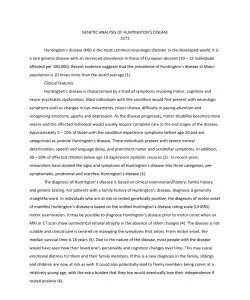GENETIC ANALYSIS OF HUNTINGTON'S DISEASE 3172
GENETIC ANALYSIS OF HUNTINGTON'S DISEASE 3172
GENETIC ANALYSIS OF HUNTINGTON'S DISEASE
3172
Huntington’s disease (HD) is the most common neurologic disorder in the developed world. It is a rare genetic disease with an increased prevalence in those of European descent (10 – 12 individuals affected per 100,000). Recent evidence suggests that the prevalence of Huntington’s disease in Maori population is 10 times more than the world average (1).
Clinical features
Huntington’s disease is characterised by a triad of symptoms involving motor, cognitive and neuro-psychiatric dysfunction. Most individuals with this condition would first present with neurologic symptoms such as changes in eye movements, minor chorea, difficulty in paying attention and recognising emotions, apathy and depression. As the disease progresses, motor disability becomes more severe and the affected individual would usually require complete care in the end stages of the disease. Approximately 5 – 10% of those with the condition experience symptoms before age 20 and are categorised as juvenile Huntington’s disease. These individuals present with severe mental deterioration, speech and language delay, and prominent motor and cerebellar symptoms. In addition, 30 – 50% of affected children below age 10 experience epileptic seizures (2).In recent years,
